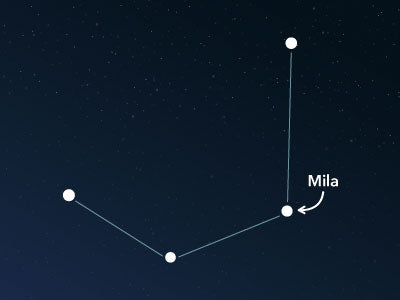The constellation Mensa
Characteristics
- Other names / Symbolism
- Table Mountain
- Hemisphere
- Southern hemisphere
- Visibility
- All year round
- Area
- 153 deg²
- Brightest star
- α Mensae (HIP number 29271)
- Specialties
- Galaxies, globular clusters

The Mensa represents the Table Mountain, a well-known mountain in Cape Town in South Africa. It is a small and inconspicuous constellation in the southern sky and was introduced in the mid-18th century by the French astronomer Nicolas Louis de Lacaille. There are only a few deep-sky objects in the area, with one particularly worth seeing.
Hemisphere, visibility, and area
The Mensa constellation is located near the south celestial pole and can be observed almost exclusively from the southern hemisphere. North of the equator, it is fully visible only up to the 5th parallel. This corresponds to places such as Bogota in Colombia or the coast of Ghana.
The constellation is circumpolar, meaning it can be observed year-round. However, the best view is in December and January, when it is high in the sky.
Mensa has an area of about 153 square degrees, making it one of the smallest constellations. Compared to all other 88 constellations, it ranks 75th in size and is also one of the darkest. There is no star in the area that is brighter than 5 mag. The most shining star is α Mensae (Alpha Mensae), with an apparent magnitude of roughly 5.1. It can only be faintly seen with the naked eye in a dark environment.
To locate Mensa in the night sky, the adjacent constellations can provide good orientation. To the north lies the Dorado, and to the east is the Hydrus (known as Small Water Snake). In the south of Mensa is the Octans, and to the west are the Chamaeleontis and the Volans.
Specialties in the constellation
In the area of the Mensa lies the exciting satellite galaxy called "Large Magellanic Cloud." It is the largest and brightest nebulous object in the entire starry sky. It contains about 15 billion stars, which is about 5% of the stars in the Milky Way.
The Large Magellanic Cloud has an apparent magnitude of about 5 and can already be observed with small telescopes. It lies on the border of the Dorado and extends across both constellations.

History
During the years 1750 to 1754, the French astronomer and mathematician Nicolas Louis de Lacaille measured the positions of over 10,000 stars using the newly invented telescope. He did this from the Cape of Good Hope near Cape Town in South Africa. In doing so, he discovered that there were some areas of the sky that were not adequately defined or needed to be divided into smaller, more manageable areas.
Thus, he eventually defined 14 new constellations, including the Mensa. The arrangement of stars reminded de Lacaille of Table Mountain, the iconic mountain of Cape Town. It is a long mountain with a large flat summit and steep sides. Therefore, the constellation Mensa is the only one dedicated to a geographical location.
PublishedRead more interesting articles

An overview of all 88 constellations
Learn more about all 88 constellations and read interesting information about the mythology, visibility, and features.

Planetarium App
Discover the night sky with our planetarium app!
Available for iOS and Android.

Name a star in the constellation Mensa
Name a star in a constellation and create something that lasts for eternity.